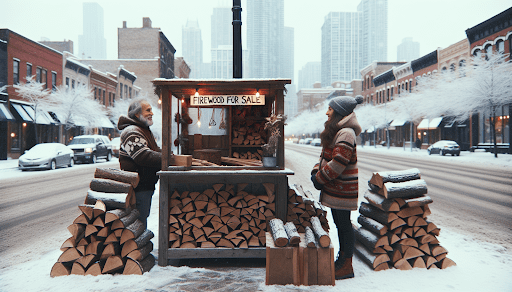Seasoned vs. Green Firewood: Understanding the Difference for Better Burning

Introduction
When it comes to firewood, Chicago IL residents have a variety of options to choose from. However, not all firewood is created equal. Understanding the difference between seasoned and green firewood is crucial for achieving optimal burning results and ensuring a safe and efficient fire. In this comprehensive guide, we’ll explore the key aspects of seasoned and green firewood, helping you make an informed decision when searching for firewood for sale Chicago IL.
What is Seasoned Firewood?
Seasoned firewood refers to wood that has been cut, split, and allowed to dry for a sufficient period, typically 6-12 months or more. During this time, the moisture content of the wood decreases, making it easier to ignite and burn efficiently. Seasoned firewood is the preferred choice for most fireplaces, wood stoves, and outdoor fire pits.
Characteristics of Seasoned Firewood
- Lower moisture content (below 20%)
- Lighter in weight compared to green firewood
- Visible cracks and splits on the ends of the logs
- Bark that easily peels off
- Distinct hollow sound when two pieces are knocked together
Benefits of Using Seasoned Firewood
- Easier to ignite and maintain a steady flame
- Produces more heat output per log
- Minimizes smoke and creosote buildup in chimneys
- Reduces the risk of chimney fires
- Cleaner and more efficient burning
What is Green Firewood?
Green firewood, on the other hand, refers to freshly cut wood that has not undergone the seasoning process. This type of firewood has a high moisture content, typically above 50%, which can lead to various issues when attempting to burn it.
Characteristics of Green Firewood
- High moisture content (above 50%)
- Heavier in weight compared to seasoned firewood
- Bark firmly attached to the logs
- No visible cracks or splits on the ends
- Dull thud sound when two pieces are knocked together
Drawbacks of Using Green Firewood
- Difficult to ignite and maintain a steady flame
- Produces less heat output per log
- Generates excessive smoke and creosote buildup
- Increases the risk of chimney fires
- Inefficient and incomplete combustion
Seasoning Process: How to Properly Dry Firewood
To transform green firewood into seasoned firewood, the seasoning process is essential. Here are the steps to properly dry your firewood:
Step 1: Cutting and Splitting
- Cut the wood into manageable lengths (16-18 inches)
- Split the logs into smaller pieces to increase surface area
Step 2: Stacking and Storing
- Choose a dry, well-ventilated area for stacking
- Stack the wood in a crisscross pattern for optimal airflow
- Avoid stacking directly on the ground to prevent moisture absorption
- Cover the top of the stack to protect from rain and snow
Step 3: Allowing Time for Drying
- Allow the firewood to season for at least 6-12 months
- Hardwoods like oak and hickory may require longer seasoning periods
- Regularly check the moisture content using a moisture meter
Identifying Properly Seasoned Firewood
When searching for firewood for sale in Chicago IL, it’s crucial to know how to identify properly seasoned firewood. Here are some tips:
Visual Inspection
- Look for visible cracks and splits on the ends of the logs
- Check if the bark is loose and easily peels off
- Observe the color of the wood (seasoned wood appears darker)
Physical Characteristics
- Seasoned firewood is lighter in weight compared to green firewood
- Two pieces of seasoned wood produce a distinct hollow sound when knocked together
Moisture Meter Testing
- Use a moisture meter to accurately measure the moisture content
- Seasoned firewood should have a moisture content below 20%
Firewood Species: Hardwoods vs. Softwoods
When considering firewood Chicago IL, it’s important to understand the differences between hardwoods and softwoods.
Hardwoods
- Examples: Oak, hickory, maple, ash
- Denser and heavier than softwoods
- Longer burning time and higher heat output
- Ideal for extended fires and cold winter nights
Softwoods
- Examples: Pine, cedar, spruce
- Lighter and less dense than hardwoods
- Faster burning time and lower heat output
- Suitable for kindling and starting fires
Storing Firewood: Best Practices
Proper storage of your firewood is essential to maintain its quality and prevent moisture absorption. Follow these best practices:
Outdoor Storage
- Store firewood at least 20 feet away from your home
- Stack the wood off the ground on a raised platform
- Use a firewood rack or pallets for improved airflow
- Cover the top of the stack with a tarp or firewood cover
Indoor Storage
- Bring only a small amount of firewood indoors at a time
- Store the wood in a dry, well-ventilated area
- Keep the firewood away from heat sources and flammable materials
- Regularly inspect for signs of pests or mold
Common Firewood Pests and How to Prevent Them
Firewood can attract various pests that can cause damage to your home or pose health risks. Here are some common firewood pests and prevention tips:
Termites
- Avoid storing firewood directly against your home’s foundation
- Regularly inspect firewood for signs of termite activity
- Use termite-resistant materials for firewood storage structures
Carpenter Ants
- Keep firewood dry and away from moisture sources
- Inspect firewood for ant colonies before bringing it indoors
- Treat infested firewood with an appropriate insecticide
Firewood Beetles
- Avoid storing firewood for extended periods (over 1 year)
- Burn older firewood first to prevent beetle infestations
- Inspect firewood for small holes or sawdust indicating beetle presence
Environmental Impact of Firewood
When using firewood, it’s important to consider the environmental impact and adopt responsible practices.
Sustainable Harvesting
- Choose firewood from sustainably managed forests
- Avoid using firewood from endangered or protected tree species
- Support local firewood suppliers who follow sustainable harvesting practices
Invasive Species Prevention
- Avoid transporting firewood long distances to prevent the spread of invasive pests
- Purchase firewood locally near your burning destination
- Follow any firewood movement regulations in your area
Firewood Alternatives
While traditional firewood is a popular choice, there are alternative options available for those seeking convenience or specific burning characteristics.
Compressed Wood Logs
- Made from compressed sawdust and wood waste
- Consistent size and shape for easy stacking and storage
- Longer burning time compared to traditional firewood
Wood Pellets
- Manufactured from compressed wood waste and sawdust
- High heat output and low moisture content
- Require a specially designed pellet stove for burning
Wax Fire Logs
- Composed of compressed sawdust and wax
- Easy to ignite and produce minimal smoke
- Convenient option for occasional fires or ambiance
Conclusion
Understanding the difference between seasoned and green firewood is essential for achieving optimal burning results and ensuring a safe and efficient fire. When searching for firewood for sale in Chicago IL, prioritize properly seasoned hardwoods for the best performance. By following proper storage and pest prevention practices, you can maintain the quality of your firewood and enjoy warm, cozy fires throughout the season.
Remember to consider the environmental impact of your firewood choices and opt for sustainable harvesting methods when possible. With this comprehensive guide, you’ll be well-equipped to make informed decisions when purchasing firewood Chicago IL and enjoy the benefits of a well-prepared and properly burning fire.





